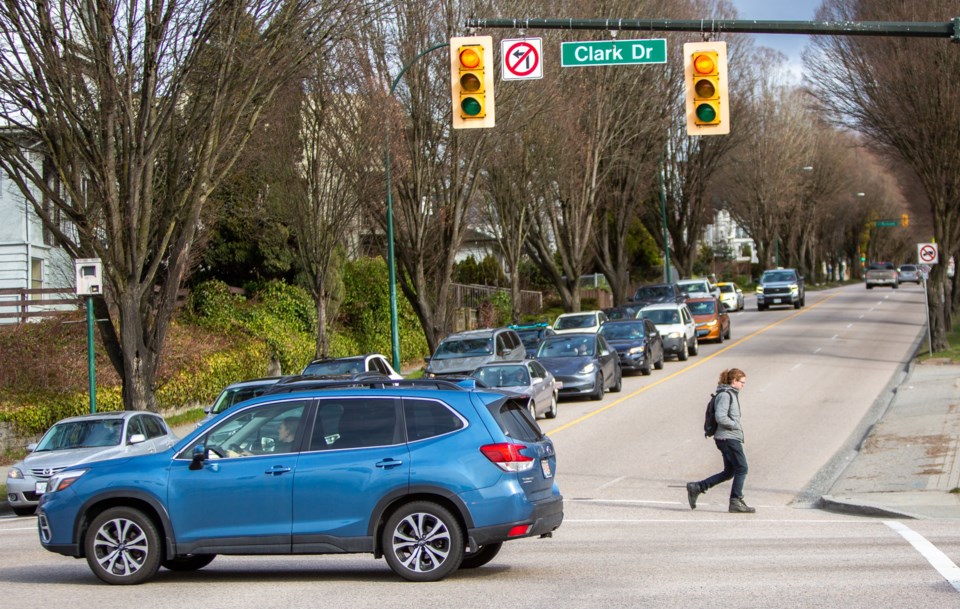The pandemic’s effect on how people get around in Vancouver continues to show an increased percentage of car trips over transit, walking or riding a bike, according to new data from the city’s transportation department.
The data showed that in 2019, roughly 46 per cent of daily trips were by car, 18 per cent by transit, 27 per cent by walking and nine per cent by cycling — one of the best years recorded by the city towards its goal of having two-thirds of all trips by 2030 to be by bike, walking, or transit.
Those percentages were based on roughly two million daily trips.
Then the pandemic hit in 2020 and Vancouver saw an emptying out of people, fewer cars on the road and only seven per cent of trips made on transit. The return to 2019 levels continues to be slow and steady, with the number of daily trips down across the board, topping 1.3 million in 2020 and creeping up to 1.5 million in 2022.
In 2022, the data showed 50 per cent of the 1.5 million trips were by car, 16 per cent by transit, 28 per cent by walking and seven per cent by bike. In 2020 and 2021, car use reached 56 per cent — the highest it’s ever been when compared to data for the period between 2013 and 2019, which averaged 50 per cent.
For context on why the slow recovery, Paul Storer, the city’s director of transportation, said extreme weather conditions in 2021 should also be factored into the data, which was May 31.
Storer cautioned council when interpreting the statistics from 2021, noting it was collected via a panel survey during the atmospheric river event, where the city and region was pounded with rain and flooding.
“I wouldn't say it's very reliable of what was happening throughout the year, but it kind of was a good indication of how more extreme weather events are impacting the way that people are moving around,” he said.
Reflecting on the pre-pandemic years, Storer said the city was seeing a steady shift between 2013 and 2019 of people choosing walking, biking and transit over a car. The data showed about a one per cent shift a year from vehicles to sustainable transportation, particularly cycling.
In fact, the cycling mode share doubled over that six-year period, “which was a big shift in how Vancouverites moved around,” said Storer, whose presentation showed cycling is still popular but that transit use is rebounding at a rate better than most North American cities.
“We're back to about 82 per cent of pre-pandemic volumes on the system,” he said, noting about two-thirds of transit trips in the region are by bus. “While the SkyTrain network is really the backbone of our transit system, buses do most of the heavy lifting.”
Storer pointed to two major projects in Vancouver that will see a further shift in cycling, walking and transit, but are currently under construction and several years from completion — the Broadway subway (anticipated to open in 2026) and the Granville Bridge connector project to make the span easier to walk and cycle over when going in and out of downtown.
“This is going to be the rapid transit project in North America that will carry the most ridership on opening day,” he said of the subway, noting the provincial government is also developing a business case for the subway to connect Arbutus with the University of British Columbia.
Traffic deaths, meanwhile, continue to decline from several decades ago when Vancouver recorded more than 21 fatalities per year from 1996 to 2007. Last year, 14 people died compared to 18 in 2021; eight died in 2020.
“We saw a big drop in the first year of the pandemic in 2020,” Storer said. “Like a lot of other cities, we unfortunately saw a big jump again in 2021, which came down again in 2022. This was really hard to see when our goal is zero [traffic-related deaths].”
Added Storer: “Each one of these [deaths] has its own story, and it's a tragedy. So we are taking a good look at each one of these, seeing what we can do to increase our safety moving forward.”
